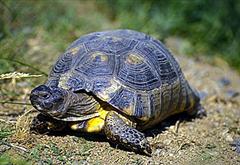Marginated Tortoise
Scientific Name: Testudo marginata
Sat, 5th July, 2025 - 7:45 pm GMT
Sponsor Ads:

Alternative Name
Scientific Name: Testudo marginataBasic Info
The largest known European Tortoise, the average Marginated Tortoise reaches about 14 inches in carapace length. As with many tortoises, the female is larger than the male. They have serrated marginals at the rear of the carapace. The Marginated Tortoise varies in coloration with many individuals having a nearly black shell and limbs, and some being mostly a dark olive color. Often, skin on the less exposed areas is a creamy or yellowish color. The large scutes on the plastron, or underside of the shell, each have a characteristic dark triangular marking in them. Marginated Tortoises are an average size tortoise. Adult individuals will grow to about 9 pounds on average, though individuals as large as 15 pounds have been reported.
Health
Marginated Tortoises, like other tortoises, like to have plenty of room to wander and graze. They should be kept outdoors if possible. Each tortoise should have at least 10 meters of space to roam in. They can climb and burrow, so the area should be quite secure. The Marginated Tortoise's diet should consist of 75 to 80 percent greens such as, but not limited to: dandelion, clover, vetch grass, alfalfa (fresh and hay), the hay is good to keep available at all times for grazing or if they get a bit hungry, tree leaves (usually prefer dry over fresh), plantain, sow thistle, weeds, chicory, endive, escarole, parsley, mustard greens, romaine lettuce, bok choy, spinach (should be fed sparingly as spinach contains oxalic acid, which interferes with the metabolism of calcium), kale, and collard greens. Some good vegetables can include: corn, beans, peas, carrots, squash (with vines and leaves), pumpkins, peppers, tomatoes, and many others. Fresh is considered better, but frozen is the other alternative. Flowers are should also be included in their diet. They love to eat pansies but morning glories are poisonous. Also watch for pesticides and fertilizers if picking food from yards and gardens. Fruits should only be given rarely, no more than once every week or two. They should be free choice feeding. Tortoises in the wild graze upon everything they come across. They can be given access to a shallow water dish, for soaking. Tortoises have a tendency to use their water dish as a "toilet". If they do this, and it is not cleaned frequently, it can cause many problems and become a breeding ground for bacteria; so rather than leaving a dish available all the time, you can soak them once or twice a week in a shallow dish for half an hour. Breeding After mating, the female will deposit a clutch of between 5 and 10 eggs in a nest she digs in the soil. The eggs can be laid at any point between 30 days and 3 years after copulation and will hatch after between 8 and 12 weeks of incubation at temperatures between 80 and 85 degrees Fahrenheit (26-31 Celsius). Lower temperatures will result in mostly male hatchlings, and higher temperatures will produce females.Habitat
They are happiest in regions with very hot summersBehavior
The Marginated Tortoise is a rare animal that can be found in only a limited domain. They are the largest of the European tortoises. Because they are rare, captive breeding is important to the survival of this species. Traversing the dry, stony lands along the coast of the Mediterranean Islands, one may come across a Marginated Tortoise. The omnivorous Marginated Tortoise will feed on both plant and animal materials, including fruit, leaves, snails, earthworms, and even feces and carrion. See special care for more information on feeding in captivity. They are happiest in regions with very hot summers, and they will brumate during cold weather. The Marginated Tortoise will live between 60 and 100 years on average.Origin
MediterraneanHistory
Found only in parts of Greece, south of Mount Olympus and sometimes in Tuscany and Sardinia, the Marginated Tortoise has a very limited domain. Because of their scarcity, it is illegal to collect and export Marginated Tortoises from their homeland. Some people have been successful, though, in breeding these tortoises in captivity.Common Foods
. Some good vegetables can include: corn, beans, peas, carrots, squash (with vines and leaves), pumpkins, peppers, tomatoes, and many others. Fresh is considered better, but frozen is the other alternative. Flowers are should also be included in their dieSponsor Ads:
"Perhaps when one wishes to prove something, one ought not to employ illustrations that are not manifest, but to illustrate the obscure by the manifest, and the things of mind by the things of sense; for the latter are more manifest." -- Aristotle. Magna Moralia.
Marginated Tortoise
Coded by: BGID® | ALL RIGHTS RESERVED Copyright © 2000-2025
Disclaimer | Privacy | Report Errors / Contact | Credits
















